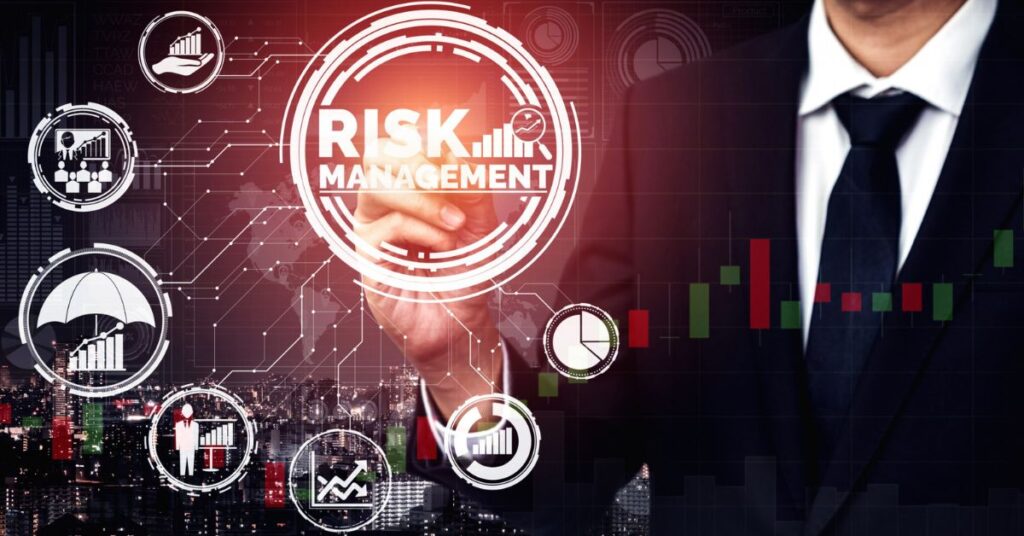There are numerous opportunities in crypto trading, but also significant risks. Prices can swing wildly, often without warning. That’s why managing risk is critical. One key step is choosing the right platform. Prime XBT is a trusted crypto trading platform with real-time resources.
It’s designed to support smarter, safer trading. Using Prime XBT, you can reduce risk and enhance your strategy with features that help you trade with confidence. So, join PrimeXBT today! Use promo code PRIMEOTT to receive a +7% bonus on your deposit.
This guide will walk you through the best risk management strategies for crypto trading. You’ll learn to protect your capital, avoid common mistakes, and build confidence. Whether you want to set stop-losses or manage emotions, we’ve got you covered. Let’s dive in.
What is Risk Management in Crypto Trading?

Risk management in cryptocurrency trading involves protecting your capital from unpredictable market fluctuations. It’s about controlling how much you lose, not just chasing gains.
Risk management is a set of strategies and rules you use before, during, and after trading. It defines how much you will lose on a single trade or over the entire portfolio. This approach helps you stay in the game even when the market turns against you.
Crypto markets are much more volatile than traditional stock markets. Prices can surge or collapse by double-digit percentages in a single day. Without a plan, emotions like fear and greed take over, leading to costly mistakes.
Effective risk management involves more than just setting stop-losses. It includes selecting the correct position size, diversifying your portfolio, and adhering to a clear trading plan. It also means being mentally prepared to accept losses and move on.
Remember, no trader wins every trade. Even the most successful cryptocurrency traders sometimes experience losses. The difference is that they manage risk so one bad trade doesn’t wipe out weeks—or months—of progress.
If you treat risk management as a core part of your strategy, you won’t just survive volatility—you’ll thrive in it.
Why Risk Management Matters in Crypto
Crypto markets operate 24/7, without breaks or closing bells. This constant movement creates incredible opportunities—but also unbelievable risks. One bad trade can quickly spiral into massive losses if you don’t have a plan.
Unlike traditional markets, crypto trading is highly speculative and often driven by news, social media, and sudden hype. Prices can fluctuate significantly within minutes. Without solid risk management, making emotional decisions, such as panic selling or buying, becomes easy due to the fear of missing out (FOMO).
History offers many lessons. Traders who lacked a strategy during events like the 2021 Bitcoin crash or sudden exchange failures suffered devastating losses. Meanwhile, those who practiced strict risk management, such as using stop-losses and smart position sizing, could protect their capital and recover more quickly.
Risk management isn’t just a defensive move. It’s an essential part of steadily growing your portfolio over time. In the crypto world, survival often leads to success.
Common Types of Risks in Crypto Trading

To succeed in crypto trading, you must first understand the risks you face. Each type affects your trades in unique ways.
Market Risk
Market risk refers to the potential loss of money due to unexpected price fluctuations. In cryptocurrency trading, market volatility is significantly higher compared to traditional assets. The prices of Bitcoin, Ethereum, or altcoins can fluctuate dramatically within minutes.
Even solid projects can experience sudden drops due to external news or market sentiment. Managing market risk means preparing for unexpected changes rather than simply hoping for the best.
Liquidity Risk
Liquidity risk occurs when buying or selling a cryptocurrency without affecting its price is difficult. Some coins, especially smaller altcoins, have low daily trading volumes, making it difficult to enter or exit trades quickly. In high-volatility situations, even significant assets can experience liquidity problems. Always check a coin’s liquidity before trading to avoid getting stuck in an unfavorable position.
Operational Risk
Operational risk involves technical issues that disrupt trading activities. These include exchange hacks, wallet failures, trading platform outages, and server issues.
Even reputable platforms can face sudden shutdowns or technical glitches at crucial times. Use trusted platforms like Prime XBT and keep your crypto assets in secure, private wallets whenever possible.
Regulatory Risk
Regulatory risk refers to the potential impact of new government laws, bans, or restrictions on crypto assets. Regulations can change rapidly and vary widely between countries.
A sudden announcement, such as a significant market crackdown, can cause massive price crashes. Stay informed about legal developments in the regions where you trade and adjust your strategies accordingly.
Psychological Risk
Psychological risk is one of the most underestimated dangers in crypto trading. Emotional reactions, such as fear, greed, impatience, and overconfidence, can undermine well-thought-out plans and strategies.
Many traders chase pumps or panic sell during dips, regretting their decisions later. Staying disciplined, using a clear trading plan, and adhering to preset rules can help you control emotional impulses and make more informed trading decisions.
Key Risk Management Strategies for Crypto Trading

Managing risk is the heart of successful crypto trading. Instead of hoping for the best, you build rules to protect your hard-earned capital. Here are the essential strategies every trader should use:
Always Use a Stop-Loss
Using a stop-loss is one of the smartest moves you can make in crypto trading. A stop-loss automatically closes your position when the market moves against you by a set amount. This limits your losses without requiring you to monitor the charts constantly.
Every trade should have a clearly defined stop-loss level based on your risk tolerance and technical analysis. Never skip it. Visit our On Tilt Trading Store for a reliable stop-loss calculator to better manage your risk and trading potential.
Risk Only What You Can Afford to Lose
Only invest what you are genuinely willing to lose. The crypto market is highly volatile; even the safest-looking trades can turn against you. Professional traders usually risk only 1%–2% of their total portfolio per trade.
This means even a losing streak won’t wipe out your entire balance. Protect your future by trading responsibly, not emotionally. Our On Tilt Trading Store has a volatility calculator to help you measure asset volatility and refine your trading strategies.
Diversify Your Portfolio
Diversification is your safety net in unpredictable markets. Instead of putting all your funds into a single coin, spread your investments across multiple cryptocurrencies. A balanced portfolio helps you minimize the impact if one asset crashes.
Include a mix of large-cap coins, such as Bitcoin and Ethereum, along with promising altcoins. Smart diversification fosters long-term stability, even in the face of volatility.
Avoid Overleveraging
Leverage can amplify your profits, but it can also destroy your account faster than you think. Overleveraging is a common mistake among crypto traders chasing quick gains. Using high leverage means even small price movements can trigger massive losses.
Platforms like Prime XBT offer flexible leverage options, but it’s best to start small and never risk everything on a single leveraged position.
Stick to a Trading Plan
A trading plan acts as your roadmap in the chaotic crypto market. It outlines when to enter and exit trades, how much to risk, and what strategies to follow. Traders often fall into emotional traps and make impulsive decisions without a plan.
Develop your plan based on thorough research, rigorous backtesting, and well-defined goals. Most importantly, follow it consistently, even when emotions tempt you to deviate from it.
Keep Emotions in Check
Emotional trading is a silent killer. Fear, greed, and impatience can undermine even the most effective trading setups. Staying emotionally neutral is critical to long-term success.
Recognize when emotions are influencing your decisions and step back if needed. Techniques such as meditation, regular breaks, or keeping a trading journal can be helpful. A cool head makes better trades than an excited one.
Stay Updated on News and Events
News moves the crypto market faster than technical indicators can. Regulatory announcements, exchange hacks, significant partnerships, or security breaches can cause sudden price shifts.
Staying informed lets you adjust your positions quickly and stay ahead of the crowd. Follow trusted news sources, set alerts, and stay informed about upcoming events that could impact the market’s mood and momentum.
How to Create a Personal Risk Management Plan

Creating a personalized risk management plan is crucial for surviving and thriving in the volatile world of cryptocurrency trading. Here’s a step-by-step guide to building a plan that fits your goals and risk tolerance:
Define Your Risk Tolerance
Start by being honest with yourself: How much risk are you comfortable taking? Some traders are aggressive and can handle high volatility, while others prefer a more cautious, steady approach.
Risk tolerance depends on factors like trading experience, financial situation, and emotional resilience. Defining this upfront will help you choose appropriate trading strategies and position sizes.
Set Clear Financial Goals
Before you even open a trade, know why you’re trading. Are you trying to build long-term wealth, generate short-term income, or gain experience? Setting clear financial goals provides direction for your trading activities. It also prevents you from making impulsive moves based on short-term market noise. Goals will shape your approach to risk and help you stay disciplined over time.
Decide How Much Capital to Allocate
Never put your entire savings into crypto trading. Decide in advance how much of your capital you are willing to allocate. Some traders dedicate only 10%–20% of their net worth to high-risk investments, such as cryptocurrencies.
Keeping the rest in safer assets protects your overall financial stability. You can further divide your funds into different trading strategies or assets within your crypto portfolio.
Establish Rules for Each Trade
Before entering a trade, set specific rules: your entry point, stop-loss level, take-profit target, and position size. Know exactly when you will exit if the market moves against you. These rules remove emotions from trading decisions, making your actions more consistent. Platforms like Prime XBT make it easy to set these parameters before opening a position.
Monitor and Adjust Your Plan Regularly
The market changes, and so should your plan. Regularly review your trading results and risk management strategies to ensure optimal performance. Are you consistently hitting your goals? Are your losses manageable?
Adjust based on the market’s performance and what you’ve learned from your trades. A flexible plan that evolves with your experience and market conditions is much more effective than a rigid one.
Common Mistakes to Avoid in Crypto Risk Management

Trading mistakes are inevitable; knowing what to avoid can prevent painful losses. Here are some of the most common risk management mistakes in crypto trading:
Ignoring Stop-Loss Orders
Many traders skip setting stop-losses because they “feel” the market will bounce back. But hope is not a strategy. Ignoring stop-losses exposes you to massive losses, especially during volatile market swings. Use stop-losses to limit potential downside and protect your capital from unexpected crashes. For a reliable stop-loss calculator, visit our On Tilt Trading Store to manage your risk and trading potential better.
Overtrading
Trading too frequently often leads to burnout and poor decision-making. Overtrading often stems from the desire to “make up” for losses or chase quick wins, which can quickly deplete your capital. Stick to your trading plan and only enter trades that meet your criteria. Quality always prevails over quantity in the long run.
Relying Too Much on Leverage
Leverage can make or break your trading journey. Many traders are drawn to high leverage for quick profits, but often overlook the risks. Overleveraging increases both your potential profits and your losses. Use leverage cautiously and only when you fully understand its impact on your trades.
Trading Without a Plan
Jumping into trades without a clear strategy is like sailing without a compass. Without a plan, you’re more likely to make emotional decisions that lead to losses. Always have a predefined plan, including entry and exit rules, risk per trade, and profit targets. Trading with a plan keeps you disciplined and focused.
Letting Emotions Drive Decisions
Fear, greed, and FOMO (fear of missing out) are potent forces in crypto trading. Making emotional decisions often leads to chasing losses or entering trades too late. Train yourself to recognize emotional impulses and stick to logic. Take breaks when needed and don’t let emotions dictate your trading actions.
Conclusion
Crypto trading offers incredible opportunities, but managing risk is crucial for lasting success. Without a clear plan, losses can accumulate quickly. Smart risk management protects your capital and builds trading confidence.
Always use stop-losses, manage position sizes effectively, and remain emotionally neutral. Reliable platforms like Prime XBT provide valuable tools for risk management. Stay informed about market trends and updates. You can trade smarter and achieve your financial goals with discipline and the right mindset.



